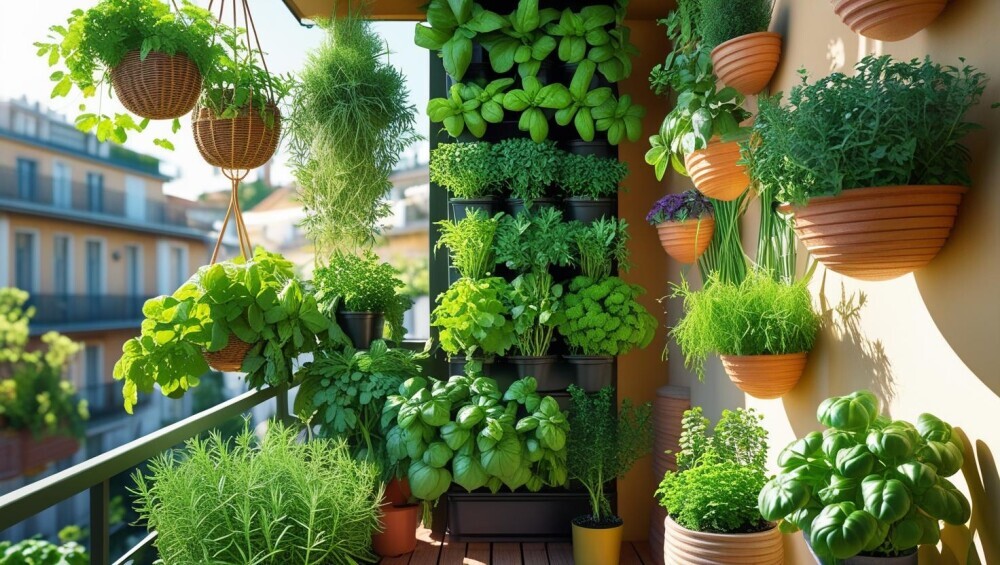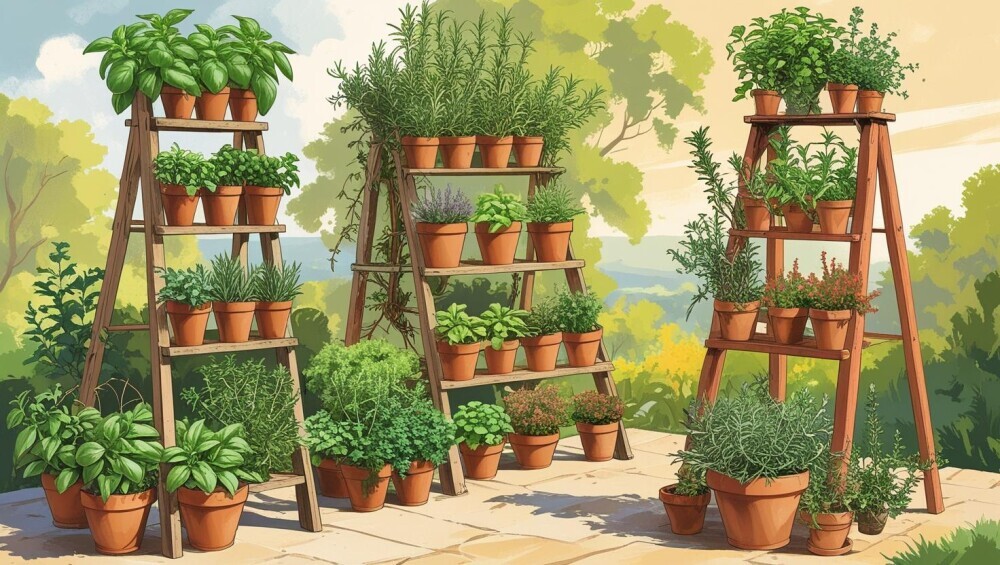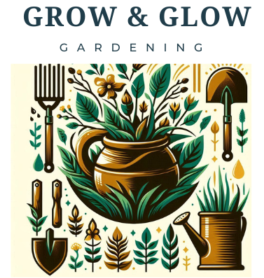Master the art of maximizing every square inch for bountiful herb harvests
Introduction: Why Small Spaces Hold BIG Potential
Don’t let limited square footage limit your herb garden dreams! Whether you’re working with a cramped apartment balcony, a tiny backyard corner, or just a sunny windowsill, small spaces can produce surprisingly abundant herb harvests. The secret lies in strategic planning, vertical thinking, and choosing the right techniques that maximize every precious inch.
Small space herb gardening isn’t just about making do with less—it’s about creating concentrated pockets of productivity that often outperform sprawling gardens. You’ll discover how compact growing methods can increase your harvest per square foot while keeping maintenance simple and enjoyable.
The Small Space Advantage: Why Bigger Isn’t Always Better
Concentrated Care Benefits
- Easier maintenance: Everything within arm’s reach
- Better pest control: Quick spotting and treatment
- Water efficiency: Targeted watering with less waste
- Higher yields per square foot: Intensive growing methods
Perfect for Beginners
- Lower initial investment
- Less overwhelming than large gardens
- Faster results and gratification
- Easy to experiment with different techniques
Essential Planning: Setting Your Small Space Foundation
Step 1: Assess Your Space
Light Assessment (Critical First Step)
- Full sun areas: 6+ hours direct sunlight (balconies, south-facing windows)
- Partial sun zones: 3-6 hours direct light (east/west windows)
- Shade areas: Less than 3 hours of direct light (north-facing spaces)
Space Measurements
- Record exact dimensions: length × width × height
- Note any obstructions (railings, overhangs, neighboring buildings)
- Identify weight-bearing surfaces for hanging gardens
Step 2: Choose Your Growing Method
Container Gardening (Most Popular)
- Perfect for renters and beginners
- Easy to move and rearrange
- Excellent drainage control
- Suitable for any surface
Vertical Growing (Maximum Space Efficiency)
- Utilizes wall space and height
- Can triple your growing area
- Creates stunning living walls
- Ideal for tiny balconies and patios
Hanging Gardens (Overhead Space Utilization)
- Frees up floor space
- Creates layers of growing zones
- Perfect for trailing herbs
- Adds visual interest at eye level
Top 10 Small Space Herb Garden Ideas
1. The Windowsill Wonderland
Best for: Apartments, kitchen growing, year-round herbs
Setup Process:
- Install a sturdy windowsill shelf or plant stand
- Choose 4-6-inch pots with drainage holes
- Position sun-loving herbs (basil, oregano) closest to the glass
- Place shade-tolerant herbs (parsley, chives) further back
Recommended Herbs: Basil, parsley, chives, thyme, small rosemary varieties
Pro Tips:
- Rotate pots weekly for even growth
- Use a humidity tray to prevent water damage
- Install grow lights for north-facing windows
2. The Stacked Tower System
Best for: Patios, balconies, small backyards
Materials Needed:
- 3-5 large containers (different sizes)
- Quality potting soil
- Watering system (drip irrigation or hand watering)
Assembly Steps:
- Place the largest container at the bottom
- Fill with potting soil, leaving a center space
- Insert the medium container in the center
- Repeat with smaller containers
- Plant herbs on each level
Planting Strategy:
- Top level: Compact herbs (thyme, oregano)
- Middle levels: Medium herbs (basil, sage)
- Bottom level: Trailing herbs (creeping thyme, oregano)
3. The Vertical Pallet Garden
Best for: Wall spaces, fence mounting, rustic aesthetics
Construction Guide:
- Prepare the pallet: Sand smooth, treat with food-safe sealant
- Add backing: Attach landscape fabric to the back and bottom
- Create shelves: Fill spaces with potting soil
- Install irrigation: Add drip lines or hand-watering access
- Plant strategically: Place herbs according to light needs
Maintenance Schedule:
- Daily: Check soil moisture in top pockets
- Weekly: Water thoroughly, check for pests
- Monthly: Fertilize with liquid organic fertilizer
4. The Hanging Herb Chandelier
 Best for: Covered patios, pergolas, and indoor spaces with ceiling hooks
Best for: Covered patios, pergolas, and indoor spaces with ceiling hooks
Materials:
- Circular hanging planter or wire basket
- Coco fiber liner or landscape fabric
- Lightweight potting mix
- Strong ceiling hook (rated for 50+ lbs)
Assembly Process:
- Line the basket with coconut fiber
- Add lightweight potting mix
- Plant herbs around the circumference
- Install a drip tray underneath
- Hang at a comfortable harvesting height
Best Herbs for Hanging:
- Trailing varieties: Creeping thyme, oregano, trailing rosemary
- Compact growers: Basil, parsley, cilantro
5. The Ladder Herb Garden
 Best for: Corners, narrow spaces, decorative displays
Best for: Corners, narrow spaces, decorative displays
Setup Instructions:
- Choose your ladder: Wooden step ladder or purpose-built plant ladder
- Weatherproof: Apply outdoor wood sealant
- Add plant holders: Attach brackets or use step surfaces
- Arrange by height: Tall herbs on the bottom, short herbs on top
- Create cohesion: Use matching containers for visual appeal
Spacing Formula:
- Allow 8-12 inches between plants
- Ensure each level gets adequate light
- Consider mature plant size when positioning
6. The Tire Tower Triumph
Best for: Recycled gardening, kid-friendly projects, rustic settings
Construction Steps:
- Prepare tires: Clean thoroughly, paint if desired
- Create drainage: Drill holes in the bottom tire
- Stack and fill: Alternate tire placement for stability
- Plant in layers: Different herbs in each tier level
- Add finishing touches: Mulch and labels
Planting Recommendations:
- Bottom tire: Large herbs (rosemary, sage)
- Middle tire: Medium herbs (basil, oregano)
- Top tire : Compact herbs (thyme, marjoram)
7. The Gutter Garden System
Best for: Fence mounting, balcony railings, modern aesthetics
Installation Guide:
- Mount gutters: Secure to fence or wall with brackets
- Add end caps: Ensure proper drainage holes
- Fill with soil: Use lightweight potting mix
- Install irrigation: Drip lines or a hand watering system
- Plant in rows: Space herbs according to mature size
Maintenance Tips:
- Check drainage regularly
- Fertilize monthly due to limited soil volume
- Harvest frequently to prevent overcrowding
8. The Shoe Organizer Herb Wall
Best for: Indoor growing, apartment balconies, temporary setups
Materials Needed:
- Clear over-door shoe organizer
- Plastic liner or landscape fabric
- Lightweight potting mix
- Small herb plants or seeds
Setup Process:
- Add drainage: Poke holes in the bottom of each pocket
- Line pockets: Add a plastic liner to prevent soil spillage
- Fill with soil: Use a lightweight, well-draining mix
- Plant herbs: One herb per pocket
- Hang securely: Use strong hooks or door hangers
Best Herbs for Pockets:
- Shallow-rooted: Cilantro, parsley, chives
- Compact varieties: Dwarf basil, thyme, oregano
9. The Magnetic Herb Garden
Best for: Metal surfaces, modern kitchens, space-efficient indoor growing
Components:
- Magnetic planters or containers with magnetic strips
- Metal surface (refrigerator, magnetic board, metal wall)
- Small herb plants
- Lightweight potting soil
Installation:
- Prepare containers: Ensure strong magnets and drainage
- Add soil and plants: Use compact, slow-growing herbs
- Position strategically: Group by watering needs
- Maintain regularly: Check daily due to the small soil volume
10. The Stackable Planter System
Best for: Modular growing, easy expansion, neat organization
System Setup:
- Choose stackable planters: Interlocking design with drainage
- Plan your layout: Consider light requirements and plant height
- Fill and plant: Use a consistent potting mix throughout
- Install watering system: Drip irrigation works best
- Label everything: Track varieties and planting dates
Expansion Strategy:
- Start with 3-4 planters
- Add more as experience grows
- Create themed sections (culinary, medicinal, aromatic)
Essential Herbs for Small Spaces
Compact Powerhouses (Perfect for Tiny Spaces)
Basil (Ocimum basilicum)
- Space requirement: 6-8 inch pot
- Growth habit: Bushy, pinchable
- Harvest period: 60-90 days continuous
- Best varieties: ‘Spicy Globe’, ‘Mini Purple’, ‘Aristotle’
Thyme (Thymus vulgaris)
- Space requirement: 4-6 inch pot
- Growth habit: Low, spreading
- Harvest period: Year-round in mild climates
- Best varieties: ‘French’, ‘Lemon’, ‘Creeping’
Oregano (Origanum vulgare)
- Space requirement: 6-8 inch pot
- Growth habit: Bushy, can trail
- Harvest period: Spring through fall
- Best varieties: ‘Greek’, ‘Hot and Spicy’, ‘Golden’
Parsley (Petroselinum crispum)
- Space requirement: 6-8 inch pot
- Growth habit: Upright, dense
- Harvest period: Year-round with succession planting
- Best varieties: ‘Moss Curled’, ‘Italian Flat Leaf’, ‘Forest Green’
Cilantro (Coriandrum sativum)
- Space requirement: 4-6 inch pot
- Growth habit: Fast-growing, bolt-prone
- Harvest period: 30-45 days
- Growing tip: Succession plant every 2-3 weeks
Vertical Growers (Excellent for Wall Systems)
Rosemary (Rosmarinus officinalis)
- Space requirement: 8-10 inch pot
- Growth habit: Upright, can be pruned
- Harvest period: Year-round
- Best varieties: ‘Upright’, ‘Tuscan Blue’, ‘Spice Islands’
Sage (Salvia officinalis)
- Space requirement: 8-10 inch pot
- Growth habit: Bushy, silvery foliage
- Harvest period: Year-round
- Best varieties: ‘Berggarten’, ‘Purple’, ‘Tricolor’
Mint (Mentha species)
- Space requirement: 6-8 inch pot (contained!)
- Growth habit: Spreading, invasive
- Harvest period: Spring through fall
- Best varieties: ‘Spearmint’, ‘Peppermint’, ‘Chocolate Mint’
Step-by-Step Setup Guide
Phase 1: Site Preparation (Week 1)
Day 1-2: Space Assessment
- Measure your available space
- Test light conditions throughout the day
- Check the weight-bearing capacity of surfaces
- Identify water access points
Day 3-4: Design Planning
- Sketch your layout on paper
- Choose your primary growing method
- Select herb varieties based on your cooking needs
- Calculate container and soil requirements
Day 5-7
- Purchase containers, soil, and tools
- Acquire seeds or starter plants
- Set up any needed infrastructure (shelving, hooks, irrigation)
Phase 2: Installation (Week 2)
Day 1-3: Container Preparation
- Drill drainage holes if needed
- Clean and prepare all containers
- Install any mounting hardware
Day 4-5
- Fill containers with quality potting mix
- Plant herbs according to spacing requirements
- Water thoroughly after planting
Day 6-7: System Setup
- Install any irrigation systems
- Set up plant labels and tracking
- Take photos for progress documentation
Phase 3: Establishment (Weeks 3-6)
Weekly Tasks:
- Monitor soil moisture daily
- Check for pest issues
- Begin light harvesting after 3-4 weeks
- Document growth progress
Adjustment Period:
- Relocate plants if needed for better light
- Adjust the watering schedule based on plant response
- Add support stakes for taller herbs
Phase 4: Production (Ongoing)
Daily Maintenance:
- Check soil moisture (finger test)
- Observe plant health and growth
- Harvest herbs as needed
Weekly Tasks:
- Deep watering session
- Pest inspection and treatment
- Deadheading spent flowers
- Rotation of containers for even growth
Monthly Activities:
- Fertilize with organic liquid fertilizer
- Prune and shape plants
- Start new succession plantings
- Evaluate and adjust growing methods
Troubleshooting Common Small Space Challenges
Problem: Plants Getting Leggy
Causes: Insufficient light, overcrowding, inadequate pruning. Solutions:
- Add grow lights for indoor setups
- Increase spacing between plants
- Pinch growing tips regularly
- Rotate plants weekly for even light exposure
Problem: Rapid Soil Drying
Causes: Small containers, hot sun exposure, and windy conditions. Solutions:
- Use larger containers when possible
- Add mulch to retain moisture
- Install drip irrigation for consistent watering
- Move containers to less exposed areas during extreme heat
Problem: Limited Harvest
Causes: Poor soil nutrition, infrequent harvesting, and overcrowding. Solutions:
- Fertilize monthly with balanced organic fertilizer
- Harvest frequently to encourage new growth
- Thin overcrowded plants
- Ensure adequate container size for root development
Problem: Pest Pressure
Causes: Stressed plants, poor air circulation, and nearby infected plants. Solutions:
- Improve spacing for air circulation
- Use companion planting (marigolds, nasturtiums)
- Apply organic pest control methods
- Quarantine new plants before introducing them to the garden
Seasonal Management for Year-Round Success
Spring Setup (March-May)
- Start cool-season herbs (cilantro, parsley, chives)
- Prepare containers and refresh the soil
- Begin succession planting schedule
- Install season extension tools if needed
Summer Maintenance (June-August)
- Focus on heat-loving herbs (basil, oregano, rosemary)
- Increase watering frequency
- Provide afternoon shade in extreme heat
- Harvest frequently to prevent bolting
Fall Transition (September-November)
- Plant cool-season herbs for winter harvest
- Begin preserving summer herb harvests
- Prepare for temperature drops
- Move tender plants to protected areas
Winter Care (December-February)
- Focus on hardy herbs (thyme, sage, rosemary)
- Reduce watering frequency
- Provide frost protection as needed
- Plan for next year’s garden expansion
Advanced Techniques for Maximum Productivity
Succession Planting Strategy
- Plant cilantro every 2-3 weeks for continuous harvest
- Stagger basil plantings for an extended season
- Use quick-growing herbs to fill gaps between slower plants
Companion Planting in Small Spaces
- Combine compatible herbs in single containers
- Use vertical companions (tall herbs shading shorter ones)
- Plant pest-deterrent herbs near vulnerable varieties
Intensive Growing Methods
- Use square-foot gardening principles
- Implement vertical growing systems
- Practice intercropping with compatible herbs
Harvest Optimization
- Learn proper cutting techniques for each herb
- Time harvests for maximum flavor concentration
- Use succession harvesting to extend plant life
Conclusion: Your Small Space, Big Flavor Journey
Small space herb gardening proves that limitations often spark the most creative and productive solutions. By implementing these space-maximizing techniques, you’ll discover that a few square feet can produce an abundance of fresh herbs year-round.
The key to success lies in thoughtful planning, consistent care, and embracing the unique advantages that small spaces offer. Your compact herb garden will not only provide fresh flavors for your kitchen but also create a green oasis that brings joy and satisfaction to your daily routine.
Remember: every expert gardener started with a single plant in a small space. Your herb garden journey begins with that first seed, that first harvest, and that first taste of homegrown flavor that makes every effort worthwhile.
Start small, think vertical, and harvest big!
Ready to transform your small space into a thriving herb paradise? Begin with one method that excites you most, and expand your garden as your confidence grows. Your future self will thank you for every fragrant leaf and flavorful harvest that comes from your perfectly planned small space herb garden.


Okay, the Hanging Herb Chandelier might just be my new garden crush! Who knew you could grow parsley and thyme while making your patio look like a botanical disco ball? I love how it uses ceiling space to free up floors and doubles as living décor practical and Pinterest-worthy! Plus, the idea of harvesting fresh cilantro from above my head just feels next-level cool. How do you keep herbs from drying out in such an exposed setup? this whole guide makes small-space gardening feel like a fun game of herb Tetris stack it, hang it, flip it, grow it
Thank you so much for your kind words and for engaging with the article! So glad the hanging Herb Chandelier caught your eye!
Botanical discoball”- I’m stealing that description!
You’re right about it, both practical AND Pinterest-worthy. There’s something magical about harvesting fresh herbs above while creating a stunning living centerpiece!
Great question about preventing dry-out in exposed setups! Here are my top tips:
Choose the right liner – coco fiber holds moisture better than plastic, plus it looks natural
Smart watering strategy – Water slowly and deeply rather than frequent light sprinkles. The elevated position helps with drainage!
Select moisture-loving herbs – parsley, cilantro, and chives. Love the slightly more humid environment that hanging creates
Timing is the key – Water in the early morning so plants have all day to absorb moisture before cooler evening temps
Location matters – Hang in spots that get morning sun but afternoon shade to reduce stress
Pro tip: Add a drip tray underneath (about 6 inches down) – it catches excess water and creates a mini humid microclimate!
Herb Tetris” is the PERFECT way to describe small-space gardening. Stack it, hang it, flip it, grow it indeed!
What’s your patio setup like? Would love to help you plan the perfect chandelier placement-Your “botanical disco ball” is going to inspire so many others!
Happy gardening
Garfield
This is a fantastic and very detailed guide for anyone looking to start an herb garden in a small space. I love how the article breaks down different creative ideas, from windowsill gardens to hanging chandeliers and even recycled tire towers! It’s clear that with a little planning and the right techniques, even the tiniest balcony or corner can become a thriving green sanctuary. The tips on choosing the right herbs for limited spaces and maximizing vertical space are especially useful. This kind of gardening feels so rewarding because it shows how you don’t need a huge yard to grow fresh, homegrown herbs. Thanks for sharing such inspiring and practical advice—definitely motivated me to get started on my own small space herb garden!
Hi Hanna
Thank you so much for such a thoughtful comment! It makes my day to hear that the article inspired you to start your own small space herb garden. That’s exactly what I hope for when writing it!
You’re so right about not needing a huge yard – some of my most productive herb gardens have been in the smallest spaces. There’s something incredibly satisfying about stepping onto a tiny balcony and snipping fresh basil for dinner, grabbing some mint for your morning tea.
I’m excited that you’re going to get started! Since you mentioned being motivated to begin. I’d love to know – are you leaning toward any particular setup? The windowsill approach is great for beginners, but those hanging gardens can be real showstoppers too.
One tip I always share with new small-space gardeners: Start with 3-4 herbs you cook with regularly. It’s so much more rewarding when you’re using your homegrown herbs in your kitchen right away. Basil, parsley, and mint are usually great starter choices.
Please keep me posted on your herb garden journey! I’d love to hear how it goes and what setup you end up choosing. And if you run into any challenges along the way, don’t hesitate to reach out -I’m always happy to help troubleshoot smallspace growing issues.
Happy gardening, and thanks again for the wonderful feedback.